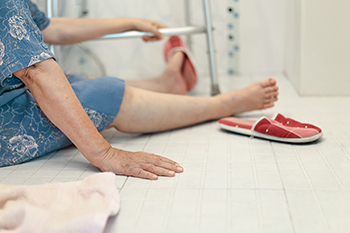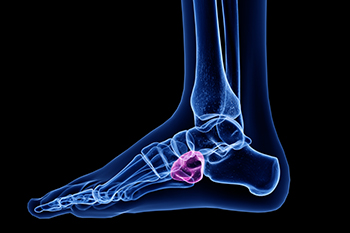Items filtered by date: August 2024
Tips for Preventing Falls

Preventing falls, especially in older adults, is essential for maintaining health and independence. As people age, factors such as muscle weakness, balance issues, and certain medical conditions can increase the likelihood of falls. Certain lifestyle changes can significantly reduce this risk. Regular exercise that focuses on strength, balance, and endurance is a key factor in preventing falls. Strengthening the core and legs improves stability, while activities like tai chi and yoga enhance balance. Further, ensuring that your home is free of hazards, like loose rugs or poor lighting, can create a safer environment. A podiatrist plays a vital role in fall prevention by assessing and addressing foot-related issues, which are often overlooked but critical for maintaining proper gait and balance. Custom orthotics, footwear recommendations, and treatment for any underlying foot problems can help reduce the risk of falls in older adults. If you have endured a foot injury from falling, it is suggested that you schedule an appointment with a podiatrist for treatment and fall prevention strategies.
Preventing falls among the elderly is very important. If you are older and have fallen or fear that you are prone to falling, consult with Leonora Fihman, DPM from California. Our doctor will assess your condition and provide you with quality advice and care.
Every 11 seconds, an elderly American is being treated in an emergency room for a fall related injury. Falls are the leading cause of head and hip injuries for those 65 and older. Due to decreases in strength, balance, senses, and lack of awareness, elderly persons are very susceptible to falling. Thankfully, there are a number of things older persons can do to prevent falls.
How to Prevent Falls
Some effective methods that older persons can do to prevent falls include:
- Enrolling in strength and balance exercise program to increase balance and strength
- Periodically having your sight and hearing checked
- Discuss any medications you have with a doctor to see if it increases the risk of falling
- Clearing the house of falling hazards and installing devices like grab bars and railings
- Utilizing a walker or cane
- Wearing shoes that provide good support and cushioning
- Talking to family members about falling and increasing awareness
Falling can be a traumatic and embarrassing experience for elderly persons; this can make them less willing to leave the house, and less willing to talk to someone about their fears of falling. Doing such things, however, will increase the likelihood of tripping or losing one’s balance. Knowing the causes of falling and how to prevent them is the best way to mitigate the risk of serious injury.
If you have any questions, please feel free to contact our offices located in Encino and Brentwood, Los Angeles, CA . We offer the newest diagnostic and treatment technologies for all your foot care needs.
Essential Ankle Stretches for Swimmers

For swimmers, maintaining flexible ankles is essential for efficient kicking and overall performance. Key stretches to incorporate into your routine include the inchworm stretch, which involves standing, bending to touch your toes, and then walking your hands forward into a plank position before walking them back. This stretch enhances both ankle flexibility and core strength. Heel raises are another effective exercise, and are done by rising onto the balls of the feet and slowly lowering back down, strengthening and stretching the calf muscles and ankles. Resistance stretches, using a resistance band, involve flexing and pointing your toes against the band’s resistance to build strength and flexibility. Integrating these stretches into your training can improve your ankle mobility, contributing to a more powerful and efficient swim session. If you have ankle pain or have sprained your ankle and would like to resume swimming, it is suggested that you consult a podiatrist who can offer you effective tips on ankle protection.
Stretching the feet is a great way to prevent injuries. If you have any concerns with your feet consult with Leonora Fihman, DPM from California. Our doctor will assess your condition and provide you with quality foot and ankle treatment.
Stretching the Feet
Stretching the muscles in the foot is an important part in any physical activity. Feet that are tight can lead to less flexibility and make you more prone to injury. One of the most common forms of foot pain, plantar fasciitis, can be stretched out to help ease the pain. Stretching can not only ease pain from plantar fasciitis but also prevent it as well. However, it is important to see a podiatrist first if stretching is right for you. Podiatrists can also recommend other ways to stretch your feet. Once you know whether stretching is right for you, here are some excellent stretches you can do.
- Using a foam roller or any cylindrical object (a water bottle or soda can will do), roll the object under your foot back and forth. You should also exert pressure on the object. Be sure to do this to both feet for a minute. Do this exercise three times each.
- Similar to the previous one, take a ball, such as a tennis ball, and roll it under your foot while seated and exert pressure on it.
- Grab a resistance band or towel and take a seat. If you are using a towel, fold it length wise. Next put either one between the ball of your foot and heel and pull with both hands on each side towards you. Hold this for 15 seconds and then switch feet. Do this three times for each foot.
- Finally hold your big toe while crossing one leg over the other. Pull the toe towards you and hold for 15 seconds. Once again do this three times per foot.
It is best to go easy when first stretching your foot and work your way up. If your foot starts hurting, stop exercising and ice and rest the foot. It is advised to then see a podiatrist for help.
If you have any questions, please feel free to contact our offices located in Encino and Brentwood, Los Angeles, CA . We offer the newest diagnostic and treatment technologies for all your foot care needs.
Foot and Ankle Edema in Pregnancy

During pregnancy, many women experience swelling, or edema, in their feet and ankles. This common issue is caused by the increased fluid retention in the body as it adjusts to support the growing baby. Gravity tends to pull these extra fluids down, leading to a noticeable buildup in the lower legs and feet. This usually starts between the 22nd and 27th weeks and continues until delivery. Swelling often worsens in the evenings and during warmer weather, which can make it tricky to wear your favorite shoes and may lead to aches and discomfort. To ease the swelling, try resting your feet, engaging in gentle exercises like walking or swimming, wearing comfy shoes, and staying well-hydrated. If you are experiencing swelling in the feet or ankles or would like personalized advice on keeping your feet and ankles in top shape throughout your pregnancy, it is suggested you make an appointment with a podiatrist.
Pregnant women with swollen feet can be treated with a variety of different methods that are readily available. For more information about other cures for swollen feet during pregnancy, consult with Leonora Fihman, DPM from California. Our doctor will attend to all of your foot and ankle needs.
What Foot Problems Can Arise During Pregnancy?
One problem that can occur is overpronation, which occurs when the arch of the foot flattens and tends to roll inward. This can cause pain and discomfort in your heels while you’re walking or even just standing up, trying to support your baby.
Another problem is edema, or swelling in the extremities. This often affects the feet during pregnancy but tends to occur in the later stages.
How Can I Keep My Feet Healthy During Pregnancy?
- Wearing orthotics can provide extra support for the feet and help distribute weight evenly
- Minimize the amount of time spent walking barefoot
- Wear shoes with good arch support
- Wear shoes that allow for good circulation to the feet
- Elevate feet if you experience swelling
- Massage your feet
- Get regular, light exercise, such as walking, to promote blood circulation to the feet
If you have any questions please feel free to contact our offices located in Encino and Brentwood, Los Angeles, CA . We offer the newest diagnostic and treatment technologies for all your foot and ankle needs.
Causes and Location of Cuboid Syndrome

Cuboid syndrome, a condition affecting the foot, involves the cuboid bone, one of the seven tarsal bones located on the outer side of the foot. Positioned between the heel bone, which is also known as the calcaneus, and the 4th and 5th metatarsal bones, the cuboid bone plays a vital role in maintaining the arch of the foot and facilitating movement. This syndrome typically arises due to repetitive stress or trauma, such as overuse injuries common in athletes or sudden twists of the foot. The exact cause often involves the displacement, or subluxation, of the cuboid bone, leading to pain and discomfort on the outer edge of the foot, sometimes radiating into the toes. Symptoms may include swelling, tenderness, and difficulty bearing weight on the affected foot. If you have pain in this part of your foot, it is suggested that you visit a podiatrist who can provide an accurate diagnosis and treatment.
Cuboid syndrome, also known as cuboid subluxation, occurs when the joints and ligaments near the cuboid bone in the foot become torn. If you have cuboid syndrome, consult with Leonora Fihman, DPM from California. Our doctor will assess your condition and provide you with quality foot and ankle treatment.
Cuboid syndrome is a common cause of lateral foot pain, which is pain on the outside of the foot. The condition may happen suddenly due to an ankle sprain, or it may develop slowly overtime from repetitive tension through the bone and surrounding structures.
Causes
The most common causes of cuboid syndrome include:
- Injury – The most common cause of this ailment is an ankle sprain.
- Repetitive Strain – Tension placed through the peroneus longus muscle from repetitive activities such as jumping and running may cause excessive traction on the bone causing it to sublux.
- Altered Foot Biomechanics – Most people suffering from cuboid subluxation have flat feet.
Symptoms
A common symptom of cuboid syndrome is pain along the outside of the foot which can be felt in the ankle and toes. This pain may create walking difficulties and may cause those with the condition to walk with a limp.
Diagnosis
Diagnosis of cuboid syndrome is often difficult, and it is often misdiagnosed. X-rays, MRIs and CT scans often fail to properly show the cuboid subluxation. Although there isn’t a specific test used to diagnose cuboid syndrome, your podiatrist will usually check if pain is felt while pressing firmly on the cuboid bone of your foot.
Treatment
Just as the range of causes varies widely, so do treatments. Some more common treatments are ice therapy, rest, exercise, taping, and orthotics.
If you have any questions, please feel free to contact our offices located in Encino and Brentwood, Los Angeles, CA . We offer the newest diagnostic and treatment technologies for all your foot care needs.

